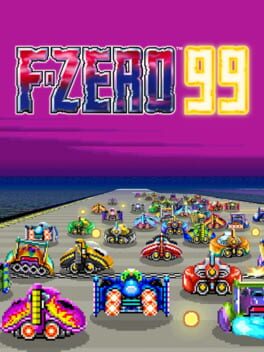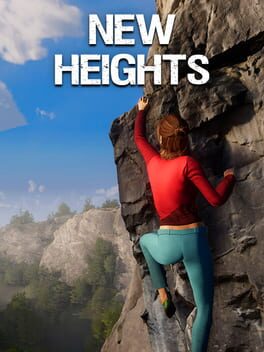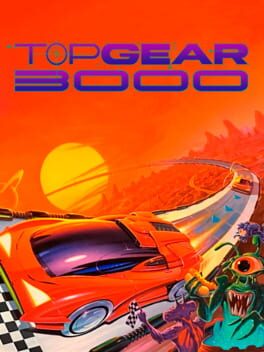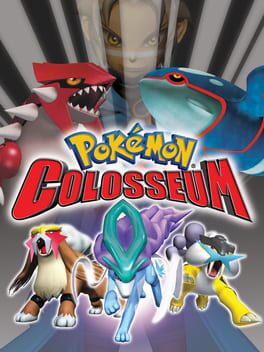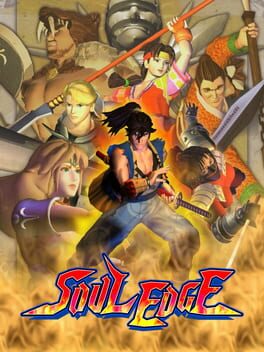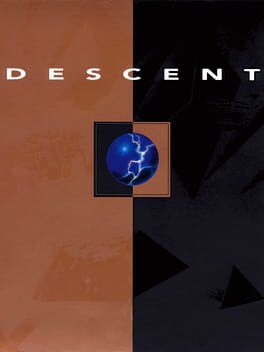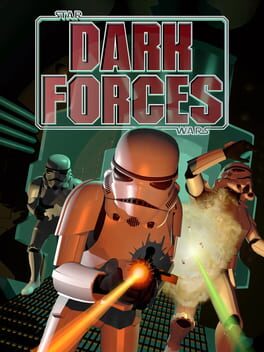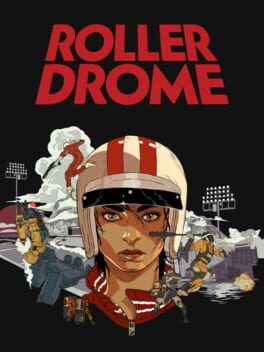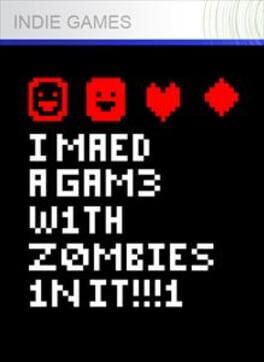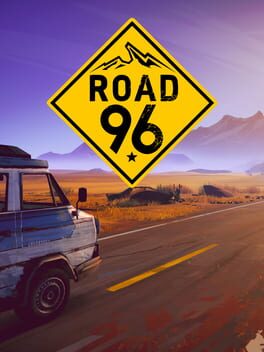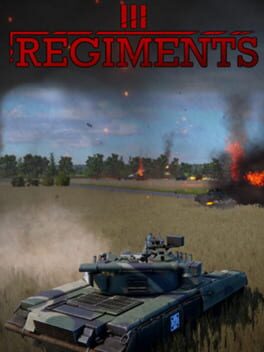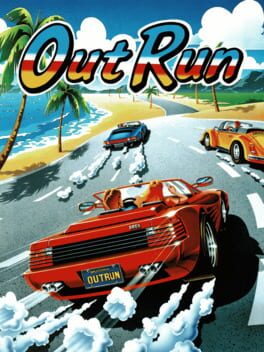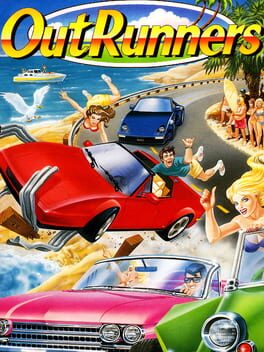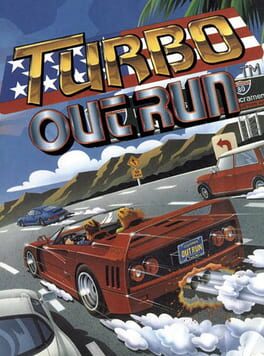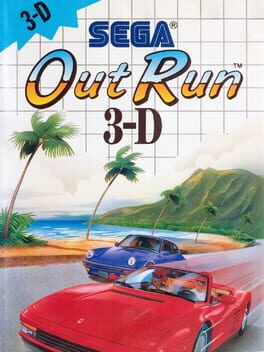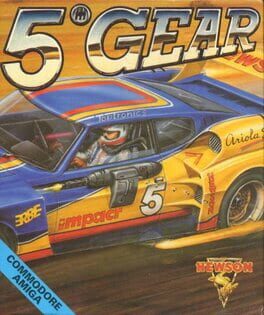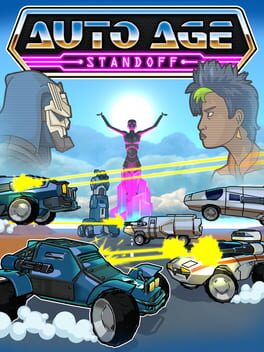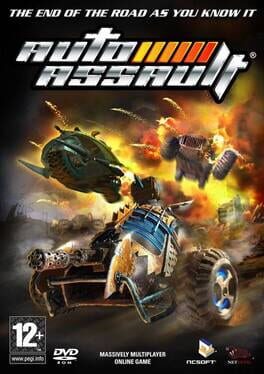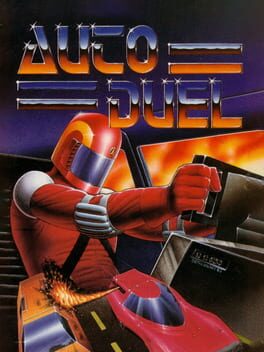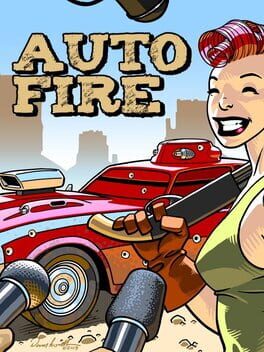nightcrawler79
BACKER
14 reviews liked by nightcrawler79
F-Zero 99
2023
This game whips so fucking hard, this is exactly what I wanted in a battle royale game. I think some machines are a little overtuned or undertuned and could use a little bit of balance changing just in terms of vehicles, and I wish there was a bit more variety in tracks on random F-Zero 99 races. More track variety is a big thing since it feels like I'm just getting popped up into Big Blue or Mute City II now every time.
Fantastic game, though! Please Nintendo don't take this down after a year let this game rock forever
Fantastic game, though! Please Nintendo don't take this down after a year let this game rock forever
F-Zero 99
2023
Can I be honest with you guys? I don’t care about F-Zero. Like at all.
The one game that I arguably had played and liked was GX, which seemed to be the common consensus, otherwise I have no string opinions one way or the other across the entire series despite the cool world and characters, it was a series that never really interested me.
So why do I find myself damn near addicted to this game?
F Zero 99 is fun, not without it faults most possibly due to the business model the game adheres to but it’s a fun, addicting, challenging and exhilarating ride.
F Zero 99 was a game that received some flack when it was revealed nearly 3 weeks ago, a direct that while fine had nothing Super note worthy other than that Paper Mario Remake. Of course as a Cing stan I lost my mind over the Another Code remake collection which obviously means Kyle Hyde will return, but too any sane person this was one of the only newer announcements. Reactions were not very good, it was elevated by it being leaked beforehand but the blow still hurt for most fans, and again I did not care. But alongside a thing I was semi excited for and got disappointed I downloaded this on my Switch and to my surprise, I had way too much fun.
This game manages to be incredibly accessible to newcomers while having a ton of depth and nuance to it. The battle royale structure fits F Zero the best out of all these 99 games since there’s a level of feedback there that’s not in any of these other games, it gets a bit chaotic sometimes but on the whole it’s a super fun time trying to survive as a person who usually isn’t a fan of these games, the elimination gimmick isn’t as prevalent as all the other games but there’s a frantic energy and euphoria climbing up the ranks and going fast, feels like an extreme version of bumper cars and I love it.
There are a few issues, due the free to play model, the stage and vehicle selection is quite limited right now, the rotation stuff for Grand Prix and such I don’t really like and is just artificial scarcity for the sake of it, and given it’s a gloried remake of the first game, the graphics aren’t anything to right home about.
But literally my main complaints are just wishing there was more of it, it’s really hard to put into word what makes this game so fun other than it’s fun to go fast, but it’s just fun to go fast. Maybe it’s because of what I played alongside it, but i had a ton of fun with F Zero 99, gonna try and get 1st and maybe even try GX again!
The one game that I arguably had played and liked was GX, which seemed to be the common consensus, otherwise I have no string opinions one way or the other across the entire series despite the cool world and characters, it was a series that never really interested me.
So why do I find myself damn near addicted to this game?
F Zero 99 is fun, not without it faults most possibly due to the business model the game adheres to but it’s a fun, addicting, challenging and exhilarating ride.
F Zero 99 was a game that received some flack when it was revealed nearly 3 weeks ago, a direct that while fine had nothing Super note worthy other than that Paper Mario Remake. Of course as a Cing stan I lost my mind over the Another Code remake collection which obviously means Kyle Hyde will return, but too any sane person this was one of the only newer announcements. Reactions were not very good, it was elevated by it being leaked beforehand but the blow still hurt for most fans, and again I did not care. But alongside a thing I was semi excited for and got disappointed I downloaded this on my Switch and to my surprise, I had way too much fun.
This game manages to be incredibly accessible to newcomers while having a ton of depth and nuance to it. The battle royale structure fits F Zero the best out of all these 99 games since there’s a level of feedback there that’s not in any of these other games, it gets a bit chaotic sometimes but on the whole it’s a super fun time trying to survive as a person who usually isn’t a fan of these games, the elimination gimmick isn’t as prevalent as all the other games but there’s a frantic energy and euphoria climbing up the ranks and going fast, feels like an extreme version of bumper cars and I love it.
There are a few issues, due the free to play model, the stage and vehicle selection is quite limited right now, the rotation stuff for Grand Prix and such I don’t really like and is just artificial scarcity for the sake of it, and given it’s a gloried remake of the first game, the graphics aren’t anything to right home about.
But literally my main complaints are just wishing there was more of it, it’s really hard to put into word what makes this game so fun other than it’s fun to go fast, but it’s just fun to go fast. Maybe it’s because of what I played alongside it, but i had a ton of fun with F Zero 99, gonna try and get 1st and maybe even try GX again!
New Heights
2023
I have been downright ravenous for good, non-VR climbing games since playing the demo for Jusant last month. Now that my appetite's been sated, I can be safely re-introduced to normal human society.
These slow traversal puzzles that require you to master a variety of micro-mechanics are my shit. The courses can be genuinely challenging, and the game skews close enough to reality that seeing an "elite" course remains intimidating well after you've familiarized yourself with the controls. Those controls will be a hurdle, too. Memorizing inputs isn't really the hard part: it's developing a sense of connection between your character's limbs and the commands you're inputting, because small mistakes are punished severely with rapid stamina loss - if you're like me you'll probably fall multiple times before the tutorial is over. Some concepts will come more naturally to IRL climbers, who will intuitively understand positioning your core to get better leverage on different holds, but you don't need to come in with any familiarity.
As it exists right now, its biggest problems are issues with ragdolling and visual clarity - on rare occasion you'll find an excellent handhold in an area that doesn't make any sense, no matter how you rotate the camera. The castle is the worst about this, but thankfully natural formations tend to adhere a little closer to what you're seeing on the screen, minimizing the time you'll spend on scavenger hunts for the right nooks and crannies. It's especially important when the game places so much emphasis on the position of each limb. Sometimes a hold that looks weak at first glance lets you position your core in such a way where your whole body is in a better position afterward (this is a good thing, btw, not a bug!). It doesn't matter if the course is rated "intermediate" when you can't find these spots that differentiate it from an elite course.
It's not the prettiest game, it frequently strays into body horror, and once you learn the mechanics you can achieve some truly ridiculous feats, but I can't really say I mind any of these. As with any good puzzle, small breakthroughs and completions are reward enough on their own, and despite how strictly you must adhere to the climbing line, there are so many ways to fuck up and fall that it still feels like a personal achievement when you make it to the end. Big recommend for anyone who's been on the hunt for a game that tries to simulate free soloing.
These slow traversal puzzles that require you to master a variety of micro-mechanics are my shit. The courses can be genuinely challenging, and the game skews close enough to reality that seeing an "elite" course remains intimidating well after you've familiarized yourself with the controls. Those controls will be a hurdle, too. Memorizing inputs isn't really the hard part: it's developing a sense of connection between your character's limbs and the commands you're inputting, because small mistakes are punished severely with rapid stamina loss - if you're like me you'll probably fall multiple times before the tutorial is over. Some concepts will come more naturally to IRL climbers, who will intuitively understand positioning your core to get better leverage on different holds, but you don't need to come in with any familiarity.
As it exists right now, its biggest problems are issues with ragdolling and visual clarity - on rare occasion you'll find an excellent handhold in an area that doesn't make any sense, no matter how you rotate the camera. The castle is the worst about this, but thankfully natural formations tend to adhere a little closer to what you're seeing on the screen, minimizing the time you'll spend on scavenger hunts for the right nooks and crannies. It's especially important when the game places so much emphasis on the position of each limb. Sometimes a hold that looks weak at first glance lets you position your core in such a way where your whole body is in a better position afterward (this is a good thing, btw, not a bug!). It doesn't matter if the course is rated "intermediate" when you can't find these spots that differentiate it from an elite course.
It's not the prettiest game, it frequently strays into body horror, and once you learn the mechanics you can achieve some truly ridiculous feats, but I can't really say I mind any of these. As with any good puzzle, small breakthroughs and completions are reward enough on their own, and despite how strictly you must adhere to the climbing line, there are so many ways to fuck up and fall that it still feels like a personal achievement when you make it to the end. Big recommend for anyone who's been on the hunt for a game that tries to simulate free soloing.
Top Gear 3000
1994
(I should indicate that I grew up with this game, so there may be a bit of nostalgia goggles here. I may not be truly impartial, but I’m not dishonest!)
Early-to-mid-90s racing games are a interesting bunch. No matter the developer, the gameplay structure was pretty identical for a majority of the notable titles – you go forward, steer left and right, and try to keep the lead and not hit obstacles. There are exceptions, of course, but reversing and turning the car around was usually out of the question.
Enter Lotus. A licensed series by the car manufacturer of the same name, it’s a trilogy of PC and Amiga racing games that follow the same exact format. While nothing too remarkable nowadays beyond some seriously good music (particularly the Amiga version; that machine could put out good stuff), it directly led into the birth of the Top Gear SNES racing games.
The Top Gear games were and are immensely popular in Brazil, and it’s not really too hard to see why – they are very pick up and play, and since the first game was always split-screen (like Super Mario Kart), couch co-op was pretty much encouraged. Not a particularly special game by any means, but I find mentioning the series’ popularity in Brazil important. That said, for a 1992 SNES racing game, it’s pretty impressive on the tech end, having actual hills and valleys in its tracks, as well as an iconic soundtrack by Barry Leitch.
Top Gear 2 came out a year later, and it’s a flat-out improvement in most gameplay areas; the fuel mechanic was removed (in TG1, players had to drive into pit stops to refuel) in favor of forcing the player to upgrade the gearbox in order to not run out of gas, tracks are generally longer, new visual effects are present (such as a 3D tunnel – in 1993 SNES!), and, lastly, instead of choosing different cars, the player could upgrade theirs with the prize money from winning races. It also had a Genesis release, which, as far as I’m aware, doesn’t have much different beyond a butchered soundtrack.
Those aren’t the game this review is about, mind you; the reason I’m mentioning them is because Top Gear 3000 is, at least personally, the apex of this specific variant of racing games. It takes everything the previous games did and improves on it considerably, albeit it’s still trapped by the limitations of the SNES and what was viable for the genre at the time. In other words, it’s the climax of the formula, but does not break through it. Anyways, getting into it:
Unlike the previous two Top Gear games, this one has a story. Two stories, in fact; the manual has an entirely different plot from what the in-game intro presents. That said, neither matters, but the important part is: this is a racing tournament… in space! This time, instead of racing through big cities, the racers are instead going through several solar systems. Fantastic (if not unique) premise for a racing game, but I have my gripes with it, but that’s for later.
This game is wildly impressive visually for a SNES game. It’s no Star Fox or whatever homebrew devs make with their tech demos nowadays, but it makes use of a special SNES enhancement chip, the DSP-4, which assists with drawing the tracks on-screen. Thanks to that, the tracks look and move smoothly compared to other games of the era. The hills, bends, and valleys present in the other games also feel more natural thanks to that, and the sprite scaling the SNES specialized in helps decorate the outskirts of the track.
Additionally, the backgrounds also look damn good. Some could do with more detail and some races lack them entirely (the ones with foggy weather, in particular), but when it lands, it lands well.
The racing is much of the same as has been described above, but Top Gear 3000 has a few tricks up its sleeve to make it stand out. First of all, tracks have multiple paths, which is possible thanks to the DSP-4. It doesn’t sound like much, but it adds a good amount of variety. Sure, you could stick to the shorter, main path, but the other paths can hide bonuses in the form of extra cash for upgrades and charges for nitro boosts. Furthermore, this is a really fast racing game, especially once you get some engine upgrades – you go blazingly fast, and sure, the tracks are 2D, but the effect is surprisingly effective when you’re the one behind the wheel thanks to the way the tracks are rendered.
The second thing Top Gear 3000 does to stand out and innovate is including power-ups. The player starts with nitro boosts, but can purchase a few additional “weapons” (none damage opponents, but that’s how the game terms them. Weird.) as the game goes, all of which have good utility. That said, boosting, jumping, and the occasional warp are usually enough to get and keep the lead. Yeah, this game’s not really hard, unless you MASSIVELY screw up and hit a lot of obstacles or completely run out of fuel. To add some difficulty, some of the tracks feature foggy/night weather (restricting vision), barriers on the track, and thinner roads.
This game brings back the fuel meter, which is instead recharged by driving over red strips during the race. It’s usually simple enough, but as the races get harder, the game makes them much thinner and infrequent, to the point where the player will likely be out of fuel for heavy chunks of the race and will have to rely on steering well enough and boosting to keep the lead. It’s a surprisingly fun challenge, which rewards knowing the track layout and having a fast reaction time with being able to keep the lead. Or, you could play safe and just stop the car over the fuel strip, but that’s kinda lame. There’s also a blue strip, which repairs damage you take during the race, which shouldn’t be an issue if you’re at least somewhat competent at racing games.
And… that’s really it for TG3000 gameplay-wise. It really doesn’t do much more than that. The weapon system and track splitting mechanics are fantastic improvements on this specific style of racing game. It also has couch co-op and four-player multiplayer; the latter sounds cool, but beyond being somewhat impressive… eh. The lack of music and barren track makes it feel empty.
My biggest problem with the game, however, is how it underutilizes its premise. The idea of a racing game throughout the galaxy is amazing, but a lot of the environments feel too Earth-like. There are some Moon-like environments, but a bit too many canyons and forests for me. It’s something the game gets better at later on, with the latter tracks featuring some futuristic cities and pretty cool geography, such as floating islands connecting to beaches and stuff of the sort. That said, it still feels like an underutilized premise.
Music is alright. It was composed by Neil Biggin, who [has stated that he was worried he didn’t quite match the genre’s expectations]( https://www.youtube.com/watch?v=RMzE5fFq-QU&list=PL090E93CE1ACA4236). And, being fair, I can see why he’d feel that way, as it’s a lot tenser compared to what I’d expect from a racing game of that era. It’s a lot tenser and not really upbeat, which adds to the space theming when the track actually does something substantial with it.
In conclusion, Top Gear 3000 is, in my opinion, the climax of this specific variant of racing games. You can play the Lotus games and work your way up and feel the improvements, with nothing feeling like it’s missing from the preceding game – even Top Gear’s spiritual sequel, Horizon Chase: Turbo, a game I have a lot of love for, is missing some of the cooler stuff like splitting tracks. Personally, I find it kind of disappointing that this direction was abandoned in favor of more realistic arcade racing with Top Gear Rally; this is just me speaking with thick nostalgia goggles on, but I firmly believe the linear improvement the genre saw stopped immediately after TG3000 (and the series itself died after some progressively worse games, both critically and commercially), and that's always saddening.
Early-to-mid-90s racing games are a interesting bunch. No matter the developer, the gameplay structure was pretty identical for a majority of the notable titles – you go forward, steer left and right, and try to keep the lead and not hit obstacles. There are exceptions, of course, but reversing and turning the car around was usually out of the question.
Enter Lotus. A licensed series by the car manufacturer of the same name, it’s a trilogy of PC and Amiga racing games that follow the same exact format. While nothing too remarkable nowadays beyond some seriously good music (particularly the Amiga version; that machine could put out good stuff), it directly led into the birth of the Top Gear SNES racing games.
The Top Gear games were and are immensely popular in Brazil, and it’s not really too hard to see why – they are very pick up and play, and since the first game was always split-screen (like Super Mario Kart), couch co-op was pretty much encouraged. Not a particularly special game by any means, but I find mentioning the series’ popularity in Brazil important. That said, for a 1992 SNES racing game, it’s pretty impressive on the tech end, having actual hills and valleys in its tracks, as well as an iconic soundtrack by Barry Leitch.
Top Gear 2 came out a year later, and it’s a flat-out improvement in most gameplay areas; the fuel mechanic was removed (in TG1, players had to drive into pit stops to refuel) in favor of forcing the player to upgrade the gearbox in order to not run out of gas, tracks are generally longer, new visual effects are present (such as a 3D tunnel – in 1993 SNES!), and, lastly, instead of choosing different cars, the player could upgrade theirs with the prize money from winning races. It also had a Genesis release, which, as far as I’m aware, doesn’t have much different beyond a butchered soundtrack.
Those aren’t the game this review is about, mind you; the reason I’m mentioning them is because Top Gear 3000 is, at least personally, the apex of this specific variant of racing games. It takes everything the previous games did and improves on it considerably, albeit it’s still trapped by the limitations of the SNES and what was viable for the genre at the time. In other words, it’s the climax of the formula, but does not break through it. Anyways, getting into it:
Unlike the previous two Top Gear games, this one has a story. Two stories, in fact; the manual has an entirely different plot from what the in-game intro presents. That said, neither matters, but the important part is: this is a racing tournament… in space! This time, instead of racing through big cities, the racers are instead going through several solar systems. Fantastic (if not unique) premise for a racing game, but I have my gripes with it, but that’s for later.
This game is wildly impressive visually for a SNES game. It’s no Star Fox or whatever homebrew devs make with their tech demos nowadays, but it makes use of a special SNES enhancement chip, the DSP-4, which assists with drawing the tracks on-screen. Thanks to that, the tracks look and move smoothly compared to other games of the era. The hills, bends, and valleys present in the other games also feel more natural thanks to that, and the sprite scaling the SNES specialized in helps decorate the outskirts of the track.
Additionally, the backgrounds also look damn good. Some could do with more detail and some races lack them entirely (the ones with foggy weather, in particular), but when it lands, it lands well.
The racing is much of the same as has been described above, but Top Gear 3000 has a few tricks up its sleeve to make it stand out. First of all, tracks have multiple paths, which is possible thanks to the DSP-4. It doesn’t sound like much, but it adds a good amount of variety. Sure, you could stick to the shorter, main path, but the other paths can hide bonuses in the form of extra cash for upgrades and charges for nitro boosts. Furthermore, this is a really fast racing game, especially once you get some engine upgrades – you go blazingly fast, and sure, the tracks are 2D, but the effect is surprisingly effective when you’re the one behind the wheel thanks to the way the tracks are rendered.
The second thing Top Gear 3000 does to stand out and innovate is including power-ups. The player starts with nitro boosts, but can purchase a few additional “weapons” (none damage opponents, but that’s how the game terms them. Weird.) as the game goes, all of which have good utility. That said, boosting, jumping, and the occasional warp are usually enough to get and keep the lead. Yeah, this game’s not really hard, unless you MASSIVELY screw up and hit a lot of obstacles or completely run out of fuel. To add some difficulty, some of the tracks feature foggy/night weather (restricting vision), barriers on the track, and thinner roads.
This game brings back the fuel meter, which is instead recharged by driving over red strips during the race. It’s usually simple enough, but as the races get harder, the game makes them much thinner and infrequent, to the point where the player will likely be out of fuel for heavy chunks of the race and will have to rely on steering well enough and boosting to keep the lead. It’s a surprisingly fun challenge, which rewards knowing the track layout and having a fast reaction time with being able to keep the lead. Or, you could play safe and just stop the car over the fuel strip, but that’s kinda lame. There’s also a blue strip, which repairs damage you take during the race, which shouldn’t be an issue if you’re at least somewhat competent at racing games.
And… that’s really it for TG3000 gameplay-wise. It really doesn’t do much more than that. The weapon system and track splitting mechanics are fantastic improvements on this specific style of racing game. It also has couch co-op and four-player multiplayer; the latter sounds cool, but beyond being somewhat impressive… eh. The lack of music and barren track makes it feel empty.
My biggest problem with the game, however, is how it underutilizes its premise. The idea of a racing game throughout the galaxy is amazing, but a lot of the environments feel too Earth-like. There are some Moon-like environments, but a bit too many canyons and forests for me. It’s something the game gets better at later on, with the latter tracks featuring some futuristic cities and pretty cool geography, such as floating islands connecting to beaches and stuff of the sort. That said, it still feels like an underutilized premise.
Music is alright. It was composed by Neil Biggin, who [has stated that he was worried he didn’t quite match the genre’s expectations]( https://www.youtube.com/watch?v=RMzE5fFq-QU&list=PL090E93CE1ACA4236). And, being fair, I can see why he’d feel that way, as it’s a lot tenser compared to what I’d expect from a racing game of that era. It’s a lot tenser and not really upbeat, which adds to the space theming when the track actually does something substantial with it.
In conclusion, Top Gear 3000 is, in my opinion, the climax of this specific variant of racing games. You can play the Lotus games and work your way up and feel the improvements, with nothing feeling like it’s missing from the preceding game – even Top Gear’s spiritual sequel, Horizon Chase: Turbo, a game I have a lot of love for, is missing some of the cooler stuff like splitting tracks. Personally, I find it kind of disappointing that this direction was abandoned in favor of more realistic arcade racing with Top Gear Rally; this is just me speaking with thick nostalgia goggles on, but I firmly believe the linear improvement the genre saw stopped immediately after TG3000 (and the series itself died after some progressively worse games, both critically and commercially), and that's always saddening.
Pokémon Colosseum
2003
me, using sunny day to turn the opposing castform into a fire type in order to kill it with magnitude damn.... pokemon is good, actually?
I have a lot of messy, conflicted opinions about Pokemon as a series. Because of the simplicity of the battle system, I don't think it's very good at really exploring all the weird interactions and possibilities that should flow naturally from its bottomless expanse of different moves, abilities and Pokemon. Where the fun instead tends to come from is the adventure - when a Pokemon game sets you free, it becomes a very personal journey. You and your hand-picked team of freaks and goofballs. Exploring abandoned buildings and blackened caves, solving ancient puzzles, only for the promise of finding more Pokemon. The freedom to do all of this, or just ignore it and power through to the finish line. Stories flourish from these journeys and the way they affect the rest of your adventure, creating a personal tale that far transcends the written stories told to you by the games.
Okay, cool, but what if we got rid of all of that?
The camera pans over a lifeless desert valley. A bomb goes off. Your protagonist emerges from the smoke, clutching the thief tool he snagged from the criminal hideout he destroyed.
Welcome to Pokemon Colosseum.
No exploration, no routes, no wild Pokemon. No adventure. This game is Pokemon in its rebellious teen phase, if the bomb wasn't enough to convince you. A world bathed in grime and rust that is only elevated by the few spots of beauty that contrast it. The verdant cliffs of Agate, the uneasy decadence of Realgam, the oppressive sludge of The Under. But it's characterised in a way that feels very familiar; as soon as he walks in, you know that this rough backdrop isn't to be taken too seriously. It allows itself to retain Pokemon's characteristic charm, even elevating it beyond the entries of the time - trainers with names like SKRUB and HUFNAK refer to each other and shit-talk each other after you beat them, guys in Power Ranger suits dropping from the sky and disappearing just as quickly as they came after you beat them; it's a batshit wild setting that avoids the pitfall of taking itself too seriously.
But if the adventure is gone, what do we get instead? A Pokemon game that is able to explore all the weird interactions and possibilities that flow naturally from its bottomless expanse of different mechanics. Colosseum is comprised solely of double battles, allowing your Pokemon to have direct synergy past having types that vaguely complement each other. Want to spam Earthquake next to a flying type? Use a Sun team with Chlorophyll and Fire types? Use Helping Hand, like, at all? All the options that you wouldn't even consider in a mainline game - anything beyond "damage move" and "setup move" - suddenly become not only usable, but appealing. This isn't just you, either - a lot of trainers also have their own themes, strategies and gimmicks. The bosses are the most distinct and memorable, but some regular trainers get their time in the sun as well. Not only does it add challenge and create memorable encounters, but it might just encourage you to build something cool, too.
The train grinds to a halt. You take a few steps forward. A bomb goes off. The door in front of you flies off its hinges, unable to hide the newly-formed chasm in the floor. The guards wonder aloud if, maybe, they took things a little too far?
And you'll need a good team, because this game does not mess around. Difficulty spikes that scrape the clouds, a level curve that curves so high that the game needs to spend the next 5 hours correcting itself. And just when you think it's gone back to normal, it shoots back off beyond the stars. It's possible to beat the game without grinding, but it'll take a good team, good tactics, and a good amount of dumb luck. And trust me, you don't want to be stuck grinding. Colosseums reward valuable TMs and money as well as the EXP reward, but do you really want to be stuck fighting level 58 Tentacools? Mt. Battle lets you buy incredibly strong items and TMs, but have fun slogging through all that if you're only starting to go there when you need it.
And how easy is it to put a good team together? The joke about the optimal team being "espeon, starter, misdreavus, 3 legendaries" is not entirely fair, but at the same time understandable. Colosseum may or may not exist to allow the missing Gen 2 Pokemon into the Gen 3 games, and, to put it nicely, they aren't known for being the strongest ones around. Some of them become more valuable in doubles, such as spread move users and supportive Pokemon, and some aren't all that bad to begin with, but while you definitely have enough tools to get through, you don't exactly have the pick of the litter.
A helicopter swoops in. They're going to get away! Was everything you did for naught? But then, an explosion. The helicopter comes crashing down.
A bomb, perhaps?
Pokemon Colosseum, through all its flaws, succeeded in making a Pokemon game that puts much higher importance on the battles. Mainline Pokemon games don't need a strong team or really all that much thought at all, and while I don't think that's necessarily a bad thing, it leaves a chasm of missed potential that a game like this is able to fill. While I get why someone would bounce off it, it plays so well off the Pokemon formula at its core that it's impossible for me not to love it. Even after I had to 100% it in Japanese to get the Bonus Disk Celebi.
And, like, it has Miror. B in it. Come on. How can it be bad if it has Miror. B in it.
I have a lot of messy, conflicted opinions about Pokemon as a series. Because of the simplicity of the battle system, I don't think it's very good at really exploring all the weird interactions and possibilities that should flow naturally from its bottomless expanse of different moves, abilities and Pokemon. Where the fun instead tends to come from is the adventure - when a Pokemon game sets you free, it becomes a very personal journey. You and your hand-picked team of freaks and goofballs. Exploring abandoned buildings and blackened caves, solving ancient puzzles, only for the promise of finding more Pokemon. The freedom to do all of this, or just ignore it and power through to the finish line. Stories flourish from these journeys and the way they affect the rest of your adventure, creating a personal tale that far transcends the written stories told to you by the games.
Okay, cool, but what if we got rid of all of that?
The camera pans over a lifeless desert valley. A bomb goes off. Your protagonist emerges from the smoke, clutching the thief tool he snagged from the criminal hideout he destroyed.
Welcome to Pokemon Colosseum.
No exploration, no routes, no wild Pokemon. No adventure. This game is Pokemon in its rebellious teen phase, if the bomb wasn't enough to convince you. A world bathed in grime and rust that is only elevated by the few spots of beauty that contrast it. The verdant cliffs of Agate, the uneasy decadence of Realgam, the oppressive sludge of The Under. But it's characterised in a way that feels very familiar; as soon as he walks in, you know that this rough backdrop isn't to be taken too seriously. It allows itself to retain Pokemon's characteristic charm, even elevating it beyond the entries of the time - trainers with names like SKRUB and HUFNAK refer to each other and shit-talk each other after you beat them, guys in Power Ranger suits dropping from the sky and disappearing just as quickly as they came after you beat them; it's a batshit wild setting that avoids the pitfall of taking itself too seriously.
But if the adventure is gone, what do we get instead? A Pokemon game that is able to explore all the weird interactions and possibilities that flow naturally from its bottomless expanse of different mechanics. Colosseum is comprised solely of double battles, allowing your Pokemon to have direct synergy past having types that vaguely complement each other. Want to spam Earthquake next to a flying type? Use a Sun team with Chlorophyll and Fire types? Use Helping Hand, like, at all? All the options that you wouldn't even consider in a mainline game - anything beyond "damage move" and "setup move" - suddenly become not only usable, but appealing. This isn't just you, either - a lot of trainers also have their own themes, strategies and gimmicks. The bosses are the most distinct and memorable, but some regular trainers get their time in the sun as well. Not only does it add challenge and create memorable encounters, but it might just encourage you to build something cool, too.
The train grinds to a halt. You take a few steps forward. A bomb goes off. The door in front of you flies off its hinges, unable to hide the newly-formed chasm in the floor. The guards wonder aloud if, maybe, they took things a little too far?
And you'll need a good team, because this game does not mess around. Difficulty spikes that scrape the clouds, a level curve that curves so high that the game needs to spend the next 5 hours correcting itself. And just when you think it's gone back to normal, it shoots back off beyond the stars. It's possible to beat the game without grinding, but it'll take a good team, good tactics, and a good amount of dumb luck. And trust me, you don't want to be stuck grinding. Colosseums reward valuable TMs and money as well as the EXP reward, but do you really want to be stuck fighting level 58 Tentacools? Mt. Battle lets you buy incredibly strong items and TMs, but have fun slogging through all that if you're only starting to go there when you need it.
And how easy is it to put a good team together? The joke about the optimal team being "espeon, starter, misdreavus, 3 legendaries" is not entirely fair, but at the same time understandable. Colosseum may or may not exist to allow the missing Gen 2 Pokemon into the Gen 3 games, and, to put it nicely, they aren't known for being the strongest ones around. Some of them become more valuable in doubles, such as spread move users and supportive Pokemon, and some aren't all that bad to begin with, but while you definitely have enough tools to get through, you don't exactly have the pick of the litter.
A helicopter swoops in. They're going to get away! Was everything you did for naught? But then, an explosion. The helicopter comes crashing down.
A bomb, perhaps?
Pokemon Colosseum, through all its flaws, succeeded in making a Pokemon game that puts much higher importance on the battles. Mainline Pokemon games don't need a strong team or really all that much thought at all, and while I don't think that's necessarily a bad thing, it leaves a chasm of missed potential that a game like this is able to fill. While I get why someone would bounce off it, it plays so well off the Pokemon formula at its core that it's impossible for me not to love it. Even after I had to 100% it in Japanese to get the Bonus Disk Celebi.
And, like, it has Miror. B in it. Come on. How can it be bad if it has Miror. B in it.
Wipeout 3
1999
The best wipeout in the PS1 trilogy easily. Courses are great, the controls are the best they have ever been, and the style is off the charts. Wipeout has always been really stylish but this game takes those late 90's Y2K vibes and absolutely goes to the MOON with em. The OST also goes pretty hard and gets ya in the wipeout trance. If you wanna see what wipeout is all about this is the game to do it with.
Soul Edge
1995
Descent
1994
So far, enjoying this one a lot more than I thought I would. Started it based on a friend's recommendation, spent most of my time with it figuring out how the hell I was supposed to comfortably map this game's controls.
I respect the hell out of what this game was going for, and found the dialogue to be surprisingly charming in its snark... but, man, this is one of the hardest to handle games I've ever played.
It doesn't feel so much like it's badly implemented, and more that I just... don't get it, yet. And that's fine! With a little practice, I'm sure it'll feel intuitive, genius, and like some kind of hidden holy grail of a game that I wish more games would control like. I know I'm not usually one for the conventions of FPS games, so this was a nice change of pace in movement that I do honestly wish more developers would strive for.
But right now, getting shot from the sides makes me freak out, fail miserably, and take a minute to consider jumping off of the nearest bridge.
I like that, though. It just makes me want to learn it even more.
I respect the hell out of what this game was going for, and found the dialogue to be surprisingly charming in its snark... but, man, this is one of the hardest to handle games I've ever played.
It doesn't feel so much like it's badly implemented, and more that I just... don't get it, yet. And that's fine! With a little practice, I'm sure it'll feel intuitive, genius, and like some kind of hidden holy grail of a game that I wish more games would control like. I know I'm not usually one for the conventions of FPS games, so this was a nice change of pace in movement that I do honestly wish more developers would strive for.
But right now, getting shot from the sides makes me freak out, fail miserably, and take a minute to consider jumping off of the nearest bridge.
I like that, though. It just makes me want to learn it even more.
Dark Forces isn't just a great FPS, but a great Star Wars game too. The aesthetic, story, and missions all capture the feeling of the original trilogy perfectly, while still finding plenty of room to chart it's own path through a galaxy far, far away.
Edit: forgot to mention I played this with the new source port, The Force Engine. Had a few visual glitches but overall it's incredible and long overdue for this game. Highly recommend using it if the DOS era clunkiness turned you off from the game.
Edit: forgot to mention I played this with the new source port, The Force Engine. Had a few visual glitches but overall it's incredible and long overdue for this game. Highly recommend using it if the DOS era clunkiness turned you off from the game.
Whether Star Wars: Dark Forces is a clone of Doom or not is completely irrelevant in this review. In fact I won’t mention Doom a single time. In any case, for this review I did 4 playthroughs of this game. First, I played original DOS version on Easy, then I played The Force Engine source port on Medium, then Playstation version on Easy, and for the last one, I played DOS original on Hard.
Star Wars: Dark Forces is a first-person shooter from the 90s. You shoot your way through storm troopers and other unpleasantries, but it’s not a simple “get to the goal” affair, the objectives in each level are different, like getting Death Star plans in the first level, then getting to the rooftop to the space ship, or putting detonative charges in a few others. Shooting the enemies is satisfying enough, blast your enemies or shoot/throw explosives at them and strafe to dodge the incoming shots, which is especially vital on harder difficulties, since the aggression and their number increases. You have two types of health, shield that can soak energy blasts and can max out at 200, and standard health, with a max of 100, that can be damaged by physical contacts, regardless of shield, or from other attacks when that is depleted. The arsenal is gradually expanded by acquiring new guns or other weapons, such as Thermal Detonators (which are like bombs) and a Jeron Fusion Cutter which looks like a musical instument. The ammo is plentiful, so you’re unlikely to run out… unless you play on hard difficulty, since I was more proactive in dodging and shooting and I was using Stormtrooper Laser Rifle in first few levels, which is fast but not super accurate or powerful, and consumes 2 energy units per shot (though I thought it used 1 ammo until I finally noticed that on my PS1 playthrough. I guess ammo really wasn’t a concern up until that point). Even then, by the IVth mission, I had enough to get by. The selection of weapons is decent enough, I used all of them in all of my playthroughs, though obviously some more than others, for instance I saved a plasma based weapon that looks like a butterfly wing (it’s not listed in the manual for some reason, so I don’t know its name, it’s mapped to 0 key) for the toughest foes like the titular dark forces or the final boss.
Aside from weapons, there are also items that have a passive effect. From the start of the game you have a flashlight that can eliminate dark areas, but you can obtain infrared goggles that give a sort of night vision, allowing to see in the dark. There's a gas mask which really is only needed in one level and I never used it ever again. Lastly, there are Ice Cleats that remove icy physics, again only found and useful in one level. Aside from shooting, there’s also secrets to uncover, a staple of first person shooters like this, containing goodies. There are more traditional bonuses you can find, aside from usual ammo there are a few power-ups, such as Shield Supercharge, which makes your shield infinite for a short time, making you invulnerable to most damage, Weapon Supercharge which makes your weapons shoot twice as fast, revive which maxes out health & shield, and lastly 1-ups. There are lives in this game like in the good ol’ Wolfenstein 3D. I only ever lost all of them once on my initial playthrough, and all it did was send me back to the previous state I’ve been in before entering the mission. I don’t know if the punishment is more severe on harder difficulties (like losing all gear), as I’ve been conservative with my lives, particularly on hard difficulty where I only allowed myself to lose a single life per mission (2 in particularly stinky ones), though most of the time I just quit the mission, which doesn’t save your life count, which can be abused.
The enemies are eager to tear you apart, and this game contains what is probably the most inaccurate depiction of Storm Troopers. They should miss 99% of the time! But seriously, the enemies can blast you as soon as you open a door for instance, which does feel a little unfair at times. Besides the level of aggression, higher difficulties also place more enemies in levels. If you thought fisting 2 dragons in Mission X: Jabba’s Ship is bad enough how about… four? Although I did find an exploit so you can fight one dragon without alerting the other at the very beginning, but still, that’s at least 3 dragons to down. There are a few occasions where it seems like there are “infinite” enemies, particularly in mission VIII: Fuel Station, where Stormtroopers appear in corridors seemingly out of nowhere, or in a big circular area with a spinning bridge, the enemies appear at the entrances even though there’s no way for them to just appear in there. I find it odd but not game breaking. IMO the most dangerous enemies, besides Dark Troopers, are Thandoshans, with their Concussion Rifle. I still don't really know how the gun works, but it basically shoots an invisible bullet that'll burst once it hits an obstacle. They're particularly nasty on hard difficulty, where they're harder to take out and damage you a fair bit. The aformentioned Dark Troopers are a threat, which is nice. The ground ones will deflect most of your shots, I found throwing explosives at them the most efficient way to take them out. The flying ones are even more dangerous, they shoot at you with aformentioned butterfly wing gun's projectiles that hit very hard and can shoot a missile. Strafing around and dodging their shots is kind of fun, if you have enough space to strafe in that is.
One innovation this game brings is the ability to look up and down (although technically Heretic did it earlier (if you want to be even more technical, CyClones did it even earlier)). In DOS version, by default, it’s mapped Page Up and Page Down keys, which is a little unwieldy, as I have to move my hand from mouse to these buttons to look where I want. Thankfully, there aren’t many places where looking up or down is necessary, and the game automatically aims at the enemies that are below or above, though changing your vertical look can increase accuracy. You can also crouch, which is used to fit into tight areas, which is used quite a bit throughout the game. In general, the game features greater emphasis on verticality compared to other games from the time. That also brings in the ability to jump, and the game features a fair bit of platforming. It’s not too bad, and I rarely missed a jump even with lower framerate which means there’s little delay, but you still have to be wary of falling off if you don’t time your jump right.
The gameplay is honestly pretty decent… if you aren’t getting lost, which isn’t all too uncommon in this game, with its labyrinthine design. It actually made me drop the game a couple times on my first playthrough, because wandering around figuring out where to go isn’t very fun. The first roadblock is Mission III: Anoat City, where you have to go through sewage tunnels and activate switches until you figure out the correct path to the destination. Mission VI: Detention Center is a multilayered tower with some walls that can be cracked with explosives, tunnels and stuff. The path forward isn’t obvious on the first playthrough, though after you figure out the way forward, it becomes routine (the way forward I found is through some ventilation, which seems to be the safest one, there must be some other way in though). However, getting stuck and confused isn’t your only concern. Some stages feature ceiling turrets that hit hard. There are also mines, while a mild annoyance on easy, they become a more frequent problem on harder difficulties. Part of it is because of their poor placement, at times they’re buried in bonues, or around the corners, or even right next to the door you’re opening, resulting in a surprising blow to your face. The best example I can list is Mission X: Jabba’s Ship, they’re almost everywhere, and as annoying as ever. Why won't they explode other enemies? We can trip our own mine, why can't they? Besides walking close to them and backing away, you can chuck explosives at them to detonate, which is a safer strat. Their placement often ends up being cheap and unfair.
Lets move onto the game’s visuals and music, where the differences between 3 different platforms are the most apparent. The original DOS and PS1 versions run at a low resolution, with further objects being the most pixelated. DOS original does feature graphical settings to increase fidelity, at the cost of the framerate. I actually lowered them to get some frames for Hard difficulty, because I felt the FPS did hinder my ability to play the game. Mind you, I don’t really care for framerates or resolution as long as the game is playable and they don’t impede my enjoyability. Given that Star Wars: Dark Forces is a pretty old game, it can’t be helped. With that being said however, I think the graphics are honestly solid, low resolution be damned. The textures are quite nice and fairly detailed, there are even neat little details, like “EWOKS SUCK!” or “PWR CELLS” in Mission VII: Ramseed Hed or someplace else, which I find kind of cute. The level geometry is nice as well, like the canyon divide gradually expands at one point, starting with a small crack in Mission IV: Research Facility, and there are rotating, moving and spinning objects in giant ship levels and other places, not only look good and make these levels more alive, but also can hide a switch that can be activated with a timed shot. The actual polygonal models like a spaceship or turrets on the other hand look primitive, the geometry isn’t very complex and the textures are lacking on some surfaces. Not to say they look bad, but they contrast with what is otherwise a solid presentation. Of course, having a big 2D spaceship would look a bit out of place. While they look basic, they’re technically impressive, at least I would assume so, I haven’t played many 90s games that feature 3D models. For cutscenes, the game uses some FMVs, as well as 2D animated cutscenes reminiscent of LucasArts’ own point and click adventure games, and the voice acting is decent. The music takes cues from some of the films’ music, and I can’t help but think that it lacks its own identity. The music isn’t particularly memorable, aside from bits that sound like classic Star Wars music. That’s not to say it’s bad, the music tracks are fitting to the levels they’re used. One credit I can give to its implementation is that its dynamic, though not in PS1 version. The music can change to battle music if the situation gets hairy, and the transition is seamless. The music is MIDI, The Force Engine makes use of uncompressed instruments, while PS1 version seems to use fully uncompressed music. It sounds great, though there are moments where the music ends and there’s silence for a few seconds before it can play again. The sound effects are quite good however.
DOS version runs at a fairly low framerate. Now, you could argue that DOS version DOES run at 60FPS, or at least it can. And I agree, it CAN run at 60. This is a difference between the game’s distribution sites and DosBox configurations. The GOG version sets its cycle count to max, meaning it can run at 60FPS. The Steam version, which is what I played, caps cycles at 20000, which is fairly low, resulting in lowered framerate. Of course, I could’ve just set that to unlimited and play the super smooth experience. But I’m a purist like that, if the publishers set it to 20000, then they must think it should provide a good experience. Anyway, moving to PS1 version’s performance, it’s not very good. The PS1 definitely has potential, if I look at a wall, the game actually runs at 60. If the game was adapted to use PS1’s 3D capabilities, then I’m sure it would’ve made for a better time. Unfortunately, they didn’t. At times it actually runs worse than the DOS version. That is on top of PS1’s unwieldy controls, I actually dreaded playing PS1 version, the aiming isn’t precise enough and you have to hold a trigger to strafe or look up and down. Of course, The Force Engine mitigates most of the issues of the base game, you can play at a higher resolution, making the picture look sharp, and at a high framerate, and you can look with a mouse both vertically and horizontally, and other goodies like mod support. If you want to play this game, the stock DOS version is fine enough, but I can highly recommend checking out The Force Engine for the quality of life improvements. Unsurprisingly, I don’t recommend the PS1 version. PC supremacy wins! I think The Force Engine shows the potential for an official remaster, in the same vein as System Shock: Enhanced Edition or Duke Nukem 3D: 20th Anniversary World Tour. While I doubt the level design would get changed or fixed, the sharper visuals and increased framerate do make for a more enjoyable experience.
Overall, Star Wars: Dark Forces is a fine enough first person shooter on its own, and it does bring some innovations and technical achievements to the table, but it’s not perfect. The level design can be confusing and the placement of mines and hazards can be an annoyance, which age it a bit. The game isn’t bad enough for me to not play it 4 times though… well, that includes PS1 version which isn’t very good, but y’know what I mean. If you’re a fan of Star Wars and/or old First Person Shooters, I can recommend this game, but be warned of its dated design.
Star Wars: Dark Forces is a first-person shooter from the 90s. You shoot your way through storm troopers and other unpleasantries, but it’s not a simple “get to the goal” affair, the objectives in each level are different, like getting Death Star plans in the first level, then getting to the rooftop to the space ship, or putting detonative charges in a few others. Shooting the enemies is satisfying enough, blast your enemies or shoot/throw explosives at them and strafe to dodge the incoming shots, which is especially vital on harder difficulties, since the aggression and their number increases. You have two types of health, shield that can soak energy blasts and can max out at 200, and standard health, with a max of 100, that can be damaged by physical contacts, regardless of shield, or from other attacks when that is depleted. The arsenal is gradually expanded by acquiring new guns or other weapons, such as Thermal Detonators (which are like bombs) and a Jeron Fusion Cutter which looks like a musical instument. The ammo is plentiful, so you’re unlikely to run out… unless you play on hard difficulty, since I was more proactive in dodging and shooting and I was using Stormtrooper Laser Rifle in first few levels, which is fast but not super accurate or powerful, and consumes 2 energy units per shot (though I thought it used 1 ammo until I finally noticed that on my PS1 playthrough. I guess ammo really wasn’t a concern up until that point). Even then, by the IVth mission, I had enough to get by. The selection of weapons is decent enough, I used all of them in all of my playthroughs, though obviously some more than others, for instance I saved a plasma based weapon that looks like a butterfly wing (it’s not listed in the manual for some reason, so I don’t know its name, it’s mapped to 0 key) for the toughest foes like the titular dark forces or the final boss.
Aside from weapons, there are also items that have a passive effect. From the start of the game you have a flashlight that can eliminate dark areas, but you can obtain infrared goggles that give a sort of night vision, allowing to see in the dark. There's a gas mask which really is only needed in one level and I never used it ever again. Lastly, there are Ice Cleats that remove icy physics, again only found and useful in one level. Aside from shooting, there’s also secrets to uncover, a staple of first person shooters like this, containing goodies. There are more traditional bonuses you can find, aside from usual ammo there are a few power-ups, such as Shield Supercharge, which makes your shield infinite for a short time, making you invulnerable to most damage, Weapon Supercharge which makes your weapons shoot twice as fast, revive which maxes out health & shield, and lastly 1-ups. There are lives in this game like in the good ol’ Wolfenstein 3D. I only ever lost all of them once on my initial playthrough, and all it did was send me back to the previous state I’ve been in before entering the mission. I don’t know if the punishment is more severe on harder difficulties (like losing all gear), as I’ve been conservative with my lives, particularly on hard difficulty where I only allowed myself to lose a single life per mission (2 in particularly stinky ones), though most of the time I just quit the mission, which doesn’t save your life count, which can be abused.
The enemies are eager to tear you apart, and this game contains what is probably the most inaccurate depiction of Storm Troopers. They should miss 99% of the time! But seriously, the enemies can blast you as soon as you open a door for instance, which does feel a little unfair at times. Besides the level of aggression, higher difficulties also place more enemies in levels. If you thought fisting 2 dragons in Mission X: Jabba’s Ship is bad enough how about… four? Although I did find an exploit so you can fight one dragon without alerting the other at the very beginning, but still, that’s at least 3 dragons to down. There are a few occasions where it seems like there are “infinite” enemies, particularly in mission VIII: Fuel Station, where Stormtroopers appear in corridors seemingly out of nowhere, or in a big circular area with a spinning bridge, the enemies appear at the entrances even though there’s no way for them to just appear in there. I find it odd but not game breaking. IMO the most dangerous enemies, besides Dark Troopers, are Thandoshans, with their Concussion Rifle. I still don't really know how the gun works, but it basically shoots an invisible bullet that'll burst once it hits an obstacle. They're particularly nasty on hard difficulty, where they're harder to take out and damage you a fair bit. The aformentioned Dark Troopers are a threat, which is nice. The ground ones will deflect most of your shots, I found throwing explosives at them the most efficient way to take them out. The flying ones are even more dangerous, they shoot at you with aformentioned butterfly wing gun's projectiles that hit very hard and can shoot a missile. Strafing around and dodging their shots is kind of fun, if you have enough space to strafe in that is.
One innovation this game brings is the ability to look up and down (although technically Heretic did it earlier (if you want to be even more technical, CyClones did it even earlier)). In DOS version, by default, it’s mapped Page Up and Page Down keys, which is a little unwieldy, as I have to move my hand from mouse to these buttons to look where I want. Thankfully, there aren’t many places where looking up or down is necessary, and the game automatically aims at the enemies that are below or above, though changing your vertical look can increase accuracy. You can also crouch, which is used to fit into tight areas, which is used quite a bit throughout the game. In general, the game features greater emphasis on verticality compared to other games from the time. That also brings in the ability to jump, and the game features a fair bit of platforming. It’s not too bad, and I rarely missed a jump even with lower framerate which means there’s little delay, but you still have to be wary of falling off if you don’t time your jump right.
The gameplay is honestly pretty decent… if you aren’t getting lost, which isn’t all too uncommon in this game, with its labyrinthine design. It actually made me drop the game a couple times on my first playthrough, because wandering around figuring out where to go isn’t very fun. The first roadblock is Mission III: Anoat City, where you have to go through sewage tunnels and activate switches until you figure out the correct path to the destination. Mission VI: Detention Center is a multilayered tower with some walls that can be cracked with explosives, tunnels and stuff. The path forward isn’t obvious on the first playthrough, though after you figure out the way forward, it becomes routine (the way forward I found is through some ventilation, which seems to be the safest one, there must be some other way in though). However, getting stuck and confused isn’t your only concern. Some stages feature ceiling turrets that hit hard. There are also mines, while a mild annoyance on easy, they become a more frequent problem on harder difficulties. Part of it is because of their poor placement, at times they’re buried in bonues, or around the corners, or even right next to the door you’re opening, resulting in a surprising blow to your face. The best example I can list is Mission X: Jabba’s Ship, they’re almost everywhere, and as annoying as ever. Why won't they explode other enemies? We can trip our own mine, why can't they? Besides walking close to them and backing away, you can chuck explosives at them to detonate, which is a safer strat. Their placement often ends up being cheap and unfair.
Lets move onto the game’s visuals and music, where the differences between 3 different platforms are the most apparent. The original DOS and PS1 versions run at a low resolution, with further objects being the most pixelated. DOS original does feature graphical settings to increase fidelity, at the cost of the framerate. I actually lowered them to get some frames for Hard difficulty, because I felt the FPS did hinder my ability to play the game. Mind you, I don’t really care for framerates or resolution as long as the game is playable and they don’t impede my enjoyability. Given that Star Wars: Dark Forces is a pretty old game, it can’t be helped. With that being said however, I think the graphics are honestly solid, low resolution be damned. The textures are quite nice and fairly detailed, there are even neat little details, like “EWOKS SUCK!” or “PWR CELLS” in Mission VII: Ramseed Hed or someplace else, which I find kind of cute. The level geometry is nice as well, like the canyon divide gradually expands at one point, starting with a small crack in Mission IV: Research Facility, and there are rotating, moving and spinning objects in giant ship levels and other places, not only look good and make these levels more alive, but also can hide a switch that can be activated with a timed shot. The actual polygonal models like a spaceship or turrets on the other hand look primitive, the geometry isn’t very complex and the textures are lacking on some surfaces. Not to say they look bad, but they contrast with what is otherwise a solid presentation. Of course, having a big 2D spaceship would look a bit out of place. While they look basic, they’re technically impressive, at least I would assume so, I haven’t played many 90s games that feature 3D models. For cutscenes, the game uses some FMVs, as well as 2D animated cutscenes reminiscent of LucasArts’ own point and click adventure games, and the voice acting is decent. The music takes cues from some of the films’ music, and I can’t help but think that it lacks its own identity. The music isn’t particularly memorable, aside from bits that sound like classic Star Wars music. That’s not to say it’s bad, the music tracks are fitting to the levels they’re used. One credit I can give to its implementation is that its dynamic, though not in PS1 version. The music can change to battle music if the situation gets hairy, and the transition is seamless. The music is MIDI, The Force Engine makes use of uncompressed instruments, while PS1 version seems to use fully uncompressed music. It sounds great, though there are moments where the music ends and there’s silence for a few seconds before it can play again. The sound effects are quite good however.
DOS version runs at a fairly low framerate. Now, you could argue that DOS version DOES run at 60FPS, or at least it can. And I agree, it CAN run at 60. This is a difference between the game’s distribution sites and DosBox configurations. The GOG version sets its cycle count to max, meaning it can run at 60FPS. The Steam version, which is what I played, caps cycles at 20000, which is fairly low, resulting in lowered framerate. Of course, I could’ve just set that to unlimited and play the super smooth experience. But I’m a purist like that, if the publishers set it to 20000, then they must think it should provide a good experience. Anyway, moving to PS1 version’s performance, it’s not very good. The PS1 definitely has potential, if I look at a wall, the game actually runs at 60. If the game was adapted to use PS1’s 3D capabilities, then I’m sure it would’ve made for a better time. Unfortunately, they didn’t. At times it actually runs worse than the DOS version. That is on top of PS1’s unwieldy controls, I actually dreaded playing PS1 version, the aiming isn’t precise enough and you have to hold a trigger to strafe or look up and down. Of course, The Force Engine mitigates most of the issues of the base game, you can play at a higher resolution, making the picture look sharp, and at a high framerate, and you can look with a mouse both vertically and horizontally, and other goodies like mod support. If you want to play this game, the stock DOS version is fine enough, but I can highly recommend checking out The Force Engine for the quality of life improvements. Unsurprisingly, I don’t recommend the PS1 version. PC supremacy wins! I think The Force Engine shows the potential for an official remaster, in the same vein as System Shock: Enhanced Edition or Duke Nukem 3D: 20th Anniversary World Tour. While I doubt the level design would get changed or fixed, the sharper visuals and increased framerate do make for a more enjoyable experience.
Overall, Star Wars: Dark Forces is a fine enough first person shooter on its own, and it does bring some innovations and technical achievements to the table, but it’s not perfect. The level design can be confusing and the placement of mines and hazards can be an annoyance, which age it a bit. The game isn’t bad enough for me to not play it 4 times though… well, that includes PS1 version which isn’t very good, but y’know what I mean. If you’re a fan of Star Wars and/or old First Person Shooters, I can recommend this game, but be warned of its dated design.
3 lists liked by nightcrawler79
